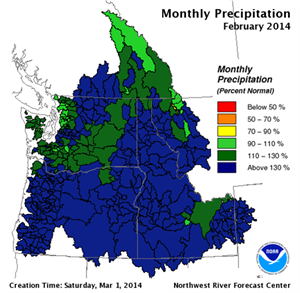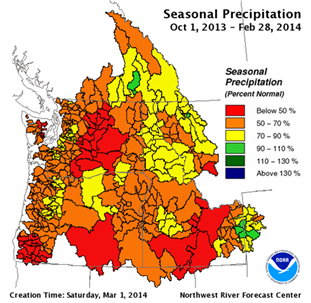February rain and snow rescued an otherwise dry winter
- March 14, 2014
- John Harrison


February precipitation boosted snowpack in the Columbia River Basin to near-normal levels, turning a winter that was shaping up as abnormally dry into one that will be close to normal, Power Council staff reported in March.
An analysis of the anticipated water supply for the March-September timeframe suggests that the electricity supply will be adequate. About half of the region’s electricity is generated at hydropower dams. River flows, reservoir elevations behind dams, hydropower generation, and revenue from the sale of hydropower all will be close to average, John Fazio, senior power systems analyst, and Jim Ruff, manager of mainstem passage and river operations, told the Council.
A slightly different measure of annual water volume, Columbia River runoff for the January-July period, predicts runoff measured at The Dalles Dam at 100 million acre-feet, just 1 million acre-feet below the annual average (since 1929) of 101 million acre-feet.
Until the unusually wet February, the winter of 2013-14 was shaping up as quite dry, with precipitation throughout the Columbia River Basin ranging from 50-70 percent of normal. While snowpack in the Columbia River Basin above The Dalles was above average on March 1, that is not the case in California where recent rain and snow has not significantly improved an abnormally dry winter.
Here are the runoff predictions in millions of acre-feet for key forecasting sites in the Columbia River Basin, expressed as percentages of average for the last 30 years:
- Columbia River at the Arrow Lakes in British Columbia, 20.45 MAF, 93 percent
- Kootenai River at Libby Dam, 5.93 MAF, 101 percent
- South Fork Flathead River at Hungry Horse Dam, 1.97 MAF, 102 percent
- Columbia River at Grand Coulee Dam, 57.41 MAF, 101 percent
- Snake River at Brownlee Dam, 4.32 MAF, 71 percent
- Snake River at Lower Granite Dam, 22.32 MAF, 106 percent
- Willamette River at Salem, 3.96 MAF, 88 percent



